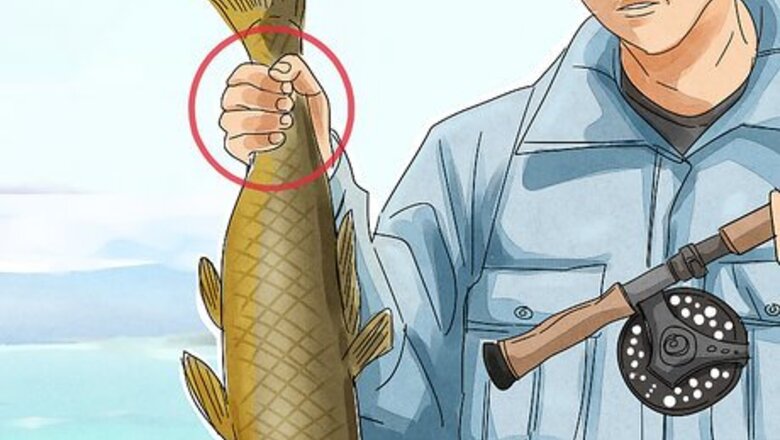
views
Reeling In a Fish
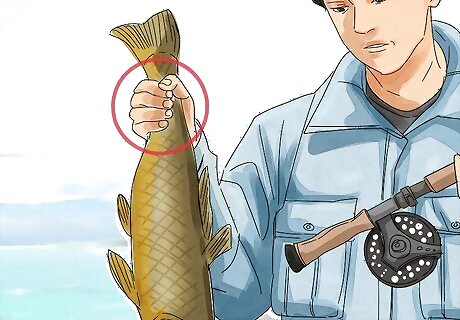
Reel the fish in until you can grab it with your hand. Keep the fish in the water as long as possible—do not bring it onto land, where it can flop about wildly, until you are close enough to grab it. Land the fish quickly. Don’t let it fight and jump until it’s exhausted. Increase the drag on your reel, and make sure that your fishing line is in good condition.
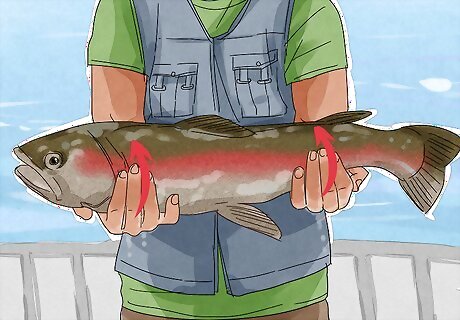
Hold the fish firmly so that it cannot wriggle free. Use one hand to grasp the fish around its pectoral fins (the fins below the gills). Place your index finger under the fish's chin to keep it from flopping around. This is a solid position, and it will be much more difficult for your catch to escape before you have removed the hook. Avoid dangling your catch by the jaw—it will flop around in the air trying to return to the water, and it will be difficult to grab it again. Consider placing the fish into a fine-meshed net that retains a bit of water. The fish will be less likely to flop around if it can lay in a bit of water. It can be much easier to remove the hook if the fish is relatively calm and you don't need to hold it in the air. You can find fine-meshed nets in fishing supply stores.
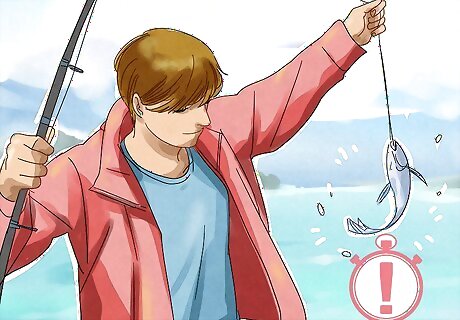
Catch it quickly. A fish that's been reeled in slowly and pushed to exhaustion is much less likely to survive after it's released. If you catch and release a fish without subjecting it to undue stress, it can recover within 24 hours, to the extent that it will show no measurable effects from the experience.
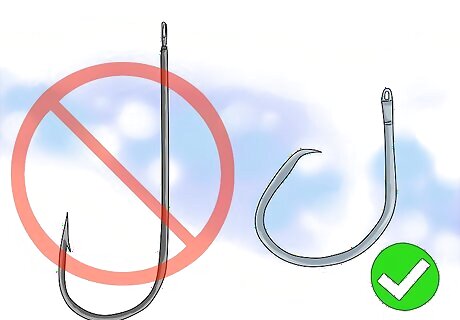
Use a barbless circle hook, not a "J" hook. If you plan to release the fish, it's important to use a humane hook that is less likely to fatally injure your catch. A J-shaped hook is much more liable to snag in a fish's guts and gill, making it difficult to humanely remove. The pointed end of the circle hook is turned perpendicular to the shank to form a loop-like shape. In general, long-shanked hooks (with a longer bit to grab above the actual hook) are much easier to remove than short-shanked hooks, although the latter may present bait better. One study showed that striped bass hooked with a circle hook were 11 times as likely to survive than those that were caught with "J" hooks. Also avoid using treble hooks—the type with three points. These hooks are much more likely to strike a blood vessel and fatally harm the fish. Consider buying soft-wire hooks that naturally unbend as you pull them from a fish. These hooks are less sturdy than traditional hooks, and thus perhaps less efficient when it comes to actually catching fish. They may be worth the lower catch count, however, if you value a humane and low-effort catch-and-release method.
Unhooking a Fish

Pull a hook straight out of a fish's lip. If the hook is caught along the edge of your catch's mouth, you can slide it out. Try not to tear the fish's lip when you pull the hook out. Take your time, and pull the hook out the same way it went in.
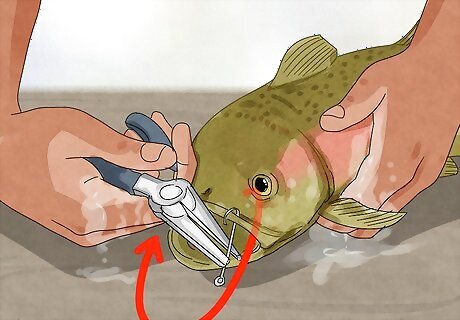
Remove a hook that a fish has swallowed. The way that you handle this situation depends on what you intend to do with the fish. If you plan to release the fish or keep it alive for another reason, you will need to be very careful not to harm the fish any further. If you plan to kill the fish anyway, you do not need to be as careful when you remove it. If you are going to eat the fish, remove the hook when you gut it. It's very important to remove the hook before cooking and eating the fish. You don't want to bite down on the hook yourself. If you cook the hook, the layer of lead that coats the hook will melt into the fish, and anyone that eats the fish will run the risk of lead poisoning. If you are throwing the fish back or otherwise keeping it alive, try to cut away a small piece of flesh and remove the hook. If you cannot remove the hook without killing your catch, cut the line as close as possible to the fish's mouth. Slide your bait over the shaft of the hook so that the fish will be able to feed regularly. Then, let the fish go. The fish will have a better chance of survival if you leave the hook in than if you rip it out.
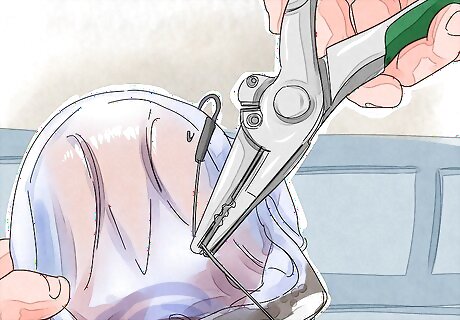
Use a pair of long-nosed pliers or scissors to reach into the fish's mouth. This tool may give you a more precise grip on the hook, and it removes any danger of the fish biting your finger. Slowly rotate the hook out the way it came. If the fish doesn't have sharp teeth, and hook is shallow enough, you can take the hook out with your fingers. Try using the pliers to bend the hook away from the entry point. If you straighten the hook, it may be easier to pull it out without harming the fish. You can also use pliers to dull the barb on your hook. This makes it easier for you to get the hook out, and catch-and-release fishing is much more humane if you don't mangle the fish.
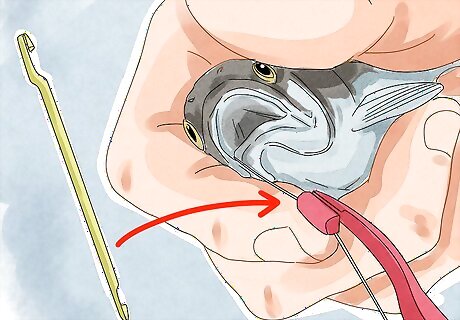
Consider using a disgorger. A disgorger is used in coarse fishing to remove a fishhook from deep inside the mouth of a fish—a hook that you cannot reach using fingers alone. The tool is typically made of plastic or metal, and it's typically used on smaller fish. To use the disgorger, slip the end over a tight line and slide it down to the bend of the hook. Push down on the tool to remove the hook. Under the pressure of the line, the hook will tighten against the end of the disgorger, allowing you to remove it from the mouth.

Decide what to do with the fish. If you are strictly fishing for fun, you can practice catch-and-release and throw the fish back into the water. You can choose to keep the fish for cooking, trophy stuffing, or keeping in an aquarium. Ultimately, you are making one choice: keep the fish, or release the fish.
Releasing a Fish
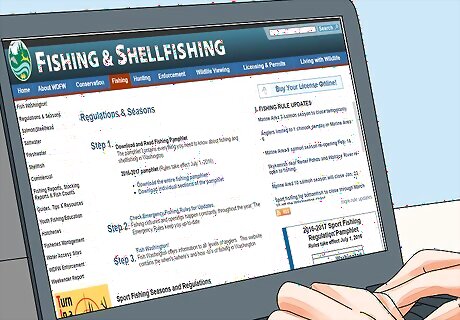
Know the law. In the U.S., you must immediately return a fish to the water if it is too small, if it is caught out of season, or if catching it puts you over the daily catch limit. Before you go fishing, research the size and quantity limits for your area. If the Department of Fish and Game has placed restrictions upon fishing in a certain area, it has done so for a reason. If you don't abide by these limits, you run the risk of depleting local fish populations, destabilizing an ecosystem, and ruining the area for future fishermen.
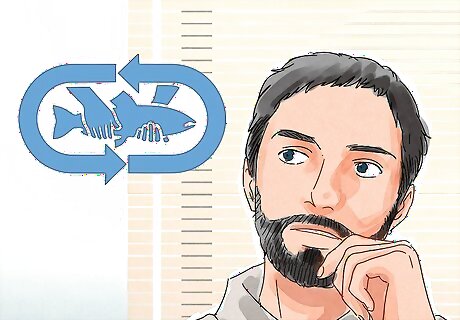
Catch and release. If you have an aversion to killing the fish (or simply don't want to go through the hassle of gutting it), you can remove the hook and release your catch back into the water from whence it came. This is the most humane choice. Be extra-careful when removing the hook—if you tear the fish's mouth or gills, it may bleed out in the water, and it may be vulnerable to attack from other fish. If you throw the fish back, release it where you caught it, and give it a chance to swim away before you cast again. Make sure to put the fish into a safe spot where it can quickly reorient itself. Never try to pull on the line to free the hook. This can severely damage the fish. Jerking the line may tug the hook through the flesh of the fish, creating deeper lacerations and making the animal more likely to bleed out in the water.
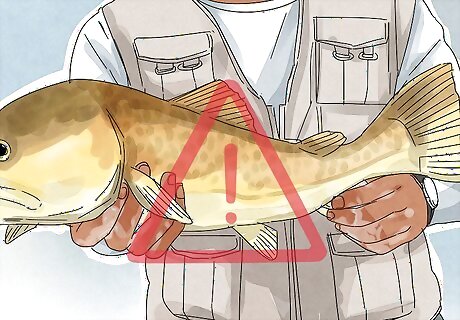
Handle the fish as little as possible. If you must touch the fish, make sure that your hands are wet.The fish's scales and protective slime may stick to dry hands, making your catch much less equipped to survive in the water.
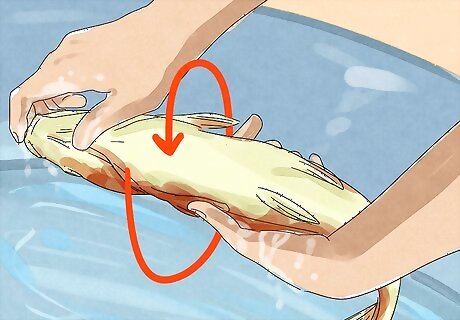
Pacify the fish to make the hook easier to remove. Hold the fish belly up in the water to disorient the fish for a few seconds. This should briefly pacify the fish, giving you enough time to remove the hook and return it to its habitat.
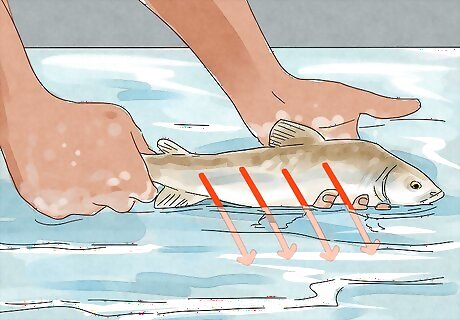
Slip the fish into the water; do not throw it. If you throw the fish at the surface of the water, it may be stunned or killed by the impact. Hold the fish firmly, in two hands, and bring it as close as possible to the water's edge before letting it wriggle free. If the fish doesn’t swim away, gently move it back and forth in the water. This helps it get a fresh dose of oxygen by moving water over its gills.













Comments
0 comment